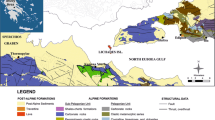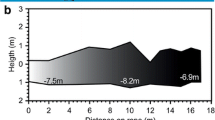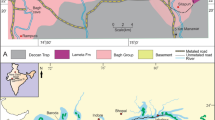Abstract
The cold-water Volkhov and warm-water Keila hardgrounds of the Ordovician Baltic Basin represent a specialized product of cyanobacterial communities of the seafloor, another member in a group containing stromatolites and microbially induced sedimentary structures. The leading role of cyanobacterial communities in the development of hardgrounds is suggested by their macrofeatures, structure, and elemental composition revealed by SEM equipped with a microprobe microanalyzer. During the formation of the hardgrounds, the cyanobacterial films were of considerable thickness (up to 4–5 mm), but lacked vertical zonation of bacterial communities, thereby being at an intermediate stage between the mature biofilms and true mats. The soft substrate underlying hardgrounds was inhabited by an abundant infauna. Thanks to bioturbation, the cyanobacterial film was in places destroyed, which prevented the development of hardgrounds. In the warm Late Ordovician basin of northern Estonia, cyanobacterial films formed hardgrounds on the surface of ripple marks. Abundant peloids and warm pore waters facilitated further cementation and hardening of the substrate underneath the hardground before the burial of the ripple marks and the hardground. Cyanobacterial films appeared simultaneously over large areas of the seafloor due to settling of planktonic bacteria. The extracellular polymeric substances (EPSs) released by these bacteria were rapidly mineralized within a maximum of one season, apparently at a depth of 15–25 m, below the fair weather wave base. The formation of hardgrounds in bioherms occurred in a shallower environment and was patchy due to the alternation of living and dead cyanobacterial mats, mineralizing mats and resulting hardgrounds. Inhabitants of biohermal hardgrounds were producers of carbonate detritus, including of micritic size, over vast areas of the seafloor surrounding the bioherm.












Similar content being viewed by others
REFERENCES
Bakterial’naya paleontologiya (Bacterial Paleontology), Rozanov, A.Yu., Ed., Moscow: Paleontol. Inst. Ross. Akad. Nauk, 2002.
Davies, N.S., Liu, A.G., Gibling, M.R., and Miller, R.F., Resolving MISS conceptions and misconceptions: A geological approach to sedimentary surface textures generated by microbial and abiotic processes, Earth Sci. Rev., 2016, no. 154, pp. 210–246.
Decho, A.W., Overview of biopolymer-induced mineralization: What goes on in biofilms?, Ecol. Engin., 2010, no. 36, pp. 137–144.
Decho, A.W., Visscher, P.T., and Reid, R.P., Production and cycling of natural microbial exopolymers (EPS) within a marine stromatolite, Palaeogeogr. Palaeoclimatol. Palaeoecol., 2005, no. 219, pp. 71–86.
Dronov, A.V. and Fedorov, P.V., New data on the structure and distribution of Hecker’s knolls in the Lower Ordovician carbonate deposits in the vicinity of Saint Petersburg, Vest. St. Peterb. Gos. Univ. Ser. 7 Geol. Geogr., 1994, vol. 2, no. 14, pp. 89–93.
Dronov, A.V. and Fedorov, P.V., Carbonate Ordovician in the vicinity of Saint Petersburg: Stratigraphy of yellow soil and friezes, Vest. St. Peterb. Gos. Univ. Ser. 7 Geol. Geogr., 1995, vol. 3, no. 21, pp. 89–93.
Dronov, A.V. and Ivantsov, A.Yu., Organogenic buildups in Lower Ordovician carbonate deposits in the vicinity of St. Petersburg, Vest. St. Peterb. Gos. Univ. Ser. 7 Geol. Geograf., 1994, vol. 1, no. 7, pp. 23–30.
Dronov, A.V. and Rozhnov, S.V., Climatic changes in the Baltoscandian Basin during the Ordovician: Sedimentological and palaeontological aspects, Acta Palaeontol. Sin., 2007, no. suppl., pp. 108–113.
Dronov, A.V., Savitskii, Yu.V., and Tsyganova, E.A., Carbonate Ordovician in the vicinity of Saint Petersburg: Stratigraphy of the Dikari Beds, Vest. St. Peterb. Gos. Univ. Ser. 7 Geol. Geogr., 1993, vol. 2, no. 14, pp. 9–16.
Dupraz, C., Reid, R.P., Braissant, O., Decho, A.W., Norman, R.S., and Visscher, P.T., Processes of carbonate precipitation in modern microbial mats, Earth Sci. Rev., 2008, pp. 1–22. doi 10.1016/j.earscirev.2008.10.005
Fedorov, P.V., Significance of the process of deposition of terrigenous suspensions of benthic biofilterers for the formation of Early Ordovician organogenic buildups of the northwestern Russian Platform, Vest. St. Peterb. Gos. Univ. Ser. 7 Geol. Geogr., 1996, vol. 2, no. 14, pp. 143–151.
Fedorov, P.V., Early Ordovician organogenic buildups of northwestern Russia: 2. Hecker’s knolls of the Tosna River valley, Vest. St. Peterb. Gos. Univ. Ser. 7 Geol. Geogr., 2000, vol. 2, no. 15, pp. 84–91.
Fedorov, P.V., Carbonate–clayey silty hills of the Lower–Middle Ordovician of Baltoskania, Candidate’s Dissertation on Geological and Mineralogical Sciences, Moscow, 2002.
Fedorov, P.V. and Dronov, A.V., Lower Ordovician organogenic buildups of the northwestern Russian Platform, in Paleogeografiya venda—rannego paleozoya Severnoi Evrazii (Paleogeography Vendian–Early Paleozoic of Northern Eurasia), Koroteev, V.A. , Eds., Ekaterinburg: Ural. Otd. Ross. Akad. Nauk, 1998a, pp. 184–191.
Fedorov, P.V. and Dronov, A.V., Lower Ordovician organogenic buildups of the northwestern Russian Platform, Vest. St. Peterb. Gos. Univ. Ser. 7 Geol. Geogr., 1998b, vol. 1, no. 7, pp. 23–30.
Fedorov, P.V. and Dronov, A.V., Early Ordovician organogenic buildups of northwestern Russia: 1. Hecker’s knolls in the Dikari Beds of the Babino plate quarry, Vest. St. Peterb. Gos. Univ. Ser. 7 Geol. Geogr., 1998c, vol. 2, no. 14, pp. 81–87.
Fedorov, P.V., Dronov, A.V., and Zavarzin, I.V., Early Ordovician organogenic buildups of northwestern Russia: 2. Hecker’s knolls of the Putilovsky quarry, Vest. St. Peterb. Gos. Univ. Ser. 7 Geol. Geogr., 1998, vol. 2, no. 14, pp. 27–36.
Flemming, H.-C. and Wingender, J., The biofilm matrix, Nat. Rev. Microbiol., 2010, vol. 8, pp. 623–633.
Gerasimenko, L.M. and Ushatinskaya, G.T., Cyanobacteria, cyanobacterial assemblages, mats, biofilms, in Bakterial’naya paleontologiya (Bacterial Paleontology), Rozanov, A.Yu., Ed., Moscow: Paleontol. Inst. Ross. Akad. Nauk, 2002, pp. 36–46.
Hints, L. and Miidel, A., Ripple marks as indicators of Late Ordovician sedimentary environments in northwest Estonia, Eston. J. Earth Sci., 2008, vol. 57, no. 1, pp. 11–22.
Karpov, G.A., Zhegallo, E.A., Gerasimenko, L.M., Zaitseva, L.V., Orleanskii, V.K., and Samylina, O.S., Biolitogenez v sovremnnykh geizeritakh Kamchatki (Biolithogenesis in Modern Geyserites of Kamchatka), Vladivostok: Dal’nauka, 2916.
Lappin-Scott, H., Burton, S., and Stoodley, P., Revealing a world of biofilms—the pioneering research of Bill Costerton, Nat. Rev. Microbiol., 2014, vol. 12, no. 11, pp. 1–7. doi 10.1038/nrmicro3343
Macintyre, I.G., Prufert-Bebout, L., and Reid, R.P., The role of endolithic cyanobacteria in the formation of lithified laminae in Bahamian stromatolites, Sedimentology, 2000, no. 47, pp. 915–921.
Palmer, T.J. and Wilson, M.A., Calcite precipitation and dissolution of biogenic aragonite in shallow Ordovician calcite seas, Lethaia. 2004, vol. 37. no. 4, pp. 417–427. 30. doi 10.1080/00241160410002135
Põlma, L., Comparative Litholigy of the Ordovician Carbonate Rocks in the Northern and Middle East Baltic, Tallinn: Valgus, 1982.
Reid, R.P. and Macintyre, I.G., Microboring versus recrystallization: Further insight into the micritization process, J. Sediment., 2000, vol. 70, pp. 24–28.
Reid, R.P., Visscher, P.T., Decho, A.W., Stolz, J.F., Bebout, B.M., Dupraz, C., Macintyre, I.G., Paerl, H.W., Pinckney, J.L., Prufert-Bebout, L., Steppe, T.F., and Desmarais, D.J., The role of microbes in accretion, lamination and early lithification of modern marine stromatolites, Nature, 2000, vol. 406, pp. 989–992.
Rozhnov, S.V., Morphogenesis and evolution of crinoids and other pelmatozoan echinoderms in the Early Paleozoic, Paleontol. J., 2002, vol. 36, no. suppl. 6, pp. S525–S674.
Rozhnov, S.V., The role of the microbial communities in the formation of hardgrounds of the Volkhov Regional Stage (Middle Ordovician, Dapinskian Stage) of the Leningrad Region, in Paleontologiya, stratigrafiya, astrobiologiya. Sbornik k 80-letiyu akademika A.Yu. Rozanova (Paleontology, Stratigraphy, and Astrobiology: Collected Works to the 80th Anniversary of the Birthday of Academician A.Yu. Rozanov), Moscow: Paleontol. Inst. Ross. Akad. Nauk, 2016a, pp. 325–337.
Rozhnov, S.V., Cyanobacterial origin and morphology of the Volchov hardgrounds (Dapingian, Middle Ordovician) of the St.-Petersburg Area (Russia), Baucon, A., Neto de Carvalho, C., and Rodrigues, J., in Ichnia2916: Abstract Book: UNESCO Geopark Naturtejo/International Ichnological Association, Castelo Branco, 2016b, pp. 182–183.
Rozhnov, S.V., Hardgrounds of the Middle Ordovician of the Baltic Paleobasin: Origin, features, and role in the evolution of benthic communities, in Mikrobnye soobshchestva v evolyutsii biosfery s drevneishikh vremen do nashikh dnei. Materialy konferentsii, posvyashchennoi pamyati Georgiya Aleksandrovicha Zavarzina: Seriya “Geo-biologicheskie protsessy v proshlom” (Conference Devoted to the Memory Georgii Aleksandrovich Zavarzin on the Microbial Communities in the Evolution of the Biosphere since the Earliest Times up to the Recent: Series Geobiological Processes in the Past), Rozhnov, S.V., Ed., Moscow: Paleontol. Inst. Ross. Akad. Nauk, 2017a, pp. 82–99.
Rozhnov, S.V., Cyanobacterial origin and morphology of the Volkhov hardgrounds (Dapingian, Middle Ordovician) of the st. Petersburg region (Russia), Boll. Soc. Paleontol. Ital., 2017b, vol. 56, no. 2, pp. 153–160. doi 10.4435/BSPI.2017.18
Rozhnov, S.V., The beginning of the Ordovician evolutionary radiation in the Baltic Region: Substrate revolution, explosive increase in diversity of stalked echinoderms, and the cyanobacterial origin of hardgrounds, in Filling the Gap between the Cambrian Explosion and the GOBE-IGCP Project 653: Annual Meeting 2017, Extended Summaries, Zhang, Y.D., Zhan, R.B., Fan, J.X., and Muir, L.A., Eds., Hangzhou: Zhejiang Univ. Press, 2017, pp. 133–139.
Rozhnov, S.V. and Fedorov, P.V., A new genus of cryptocrinitids (Eocrinoidea, Echinodermata) from near-bioherm deposits of the Volkhov Stage (Upper Areningian, Ordovik) Leningrad Region, Paleontol. Zh., 2001, no. 6, pp. 42–49.
Stoodley, P., Sauer, K., Davies, D.G., and Costerton, J.W., Biofilms as complex differentiated communities, Ann. Rev. Microbiol., 2002, no. 56, pp. 187–209.
Vinn, O., Wilson, M.A., and Toom, U., Bioerosion of inorganic hard substrates in the Ordovician of Estonia (Baltica), PLOS ONE, 2015, vol. 10, no. 7, p. e0134279. doi 10.1371/journal.pone.0134279
Vishnyakov, S.G. and Hekker, R.F., Traces of washout and intrastratal disturbances in glauconitic limestones of the Lower Silurian of the Leningrad Region, in Sbornik k 45‑letiyu nauchnoi deyatel’nosti chlena TsNIGRI doktora geologicheskikh nauk N.F. Pogrebova (Collected Works to the 45th Anniversary of Scientific Activity of the Member of TsNIGRI Doctor of Geological Science N.F. Pogrebov), Leningrad–Moscow: ONTI-NKTP, 1937, pp. 30–35.
Wilson, M.A. and Palmer, T.J., Hardgrounds and hardground faunas, Univ. Wales, Aberystwyth, Inst. Earth Stud. Publ., 1992, no. 9, pp. 1–131.
ACKNOWLEDGMENTS
I am especially indebted to L.V. Zaitseva for enormous help with operating the SEM and probe microanalyzer. I am grateful to A.Yu. Rozanov and E.A. Zhegallo for the discussions of the results, and to S.V. Bagirov for photography. The study is supported by the Russian Foundation for Basic Research, project no. 18-04-01046 A, Program of Fundamental Research of the Presidium of the Russian Academy of Sciences no. 17 “Evolution of the Organic World: Role and Influence of Planetary Processes.” This paper is a contribution to the International Geoscience Program (IGCP), Project 653, “The Onset of the Great Ordovician Biodiversification Event.”
Author information
Authors and Affiliations
Corresponding author
Additional information
Translated by S. Nikolaeva
Rights and permissions
About this article
Cite this article
Rozhnov, S.V. Hardgrounds of the Ordovician Baltic Paleobasin as a Distinct Type of Sedimentation Induced by Cyanobacterial Mats. Paleontol. J. 52, 1098–1113 (2018). https://doi.org/10.1134/S0031030118100118
Received:
Published:
Issue Date:
DOI: https://doi.org/10.1134/S0031030118100118




